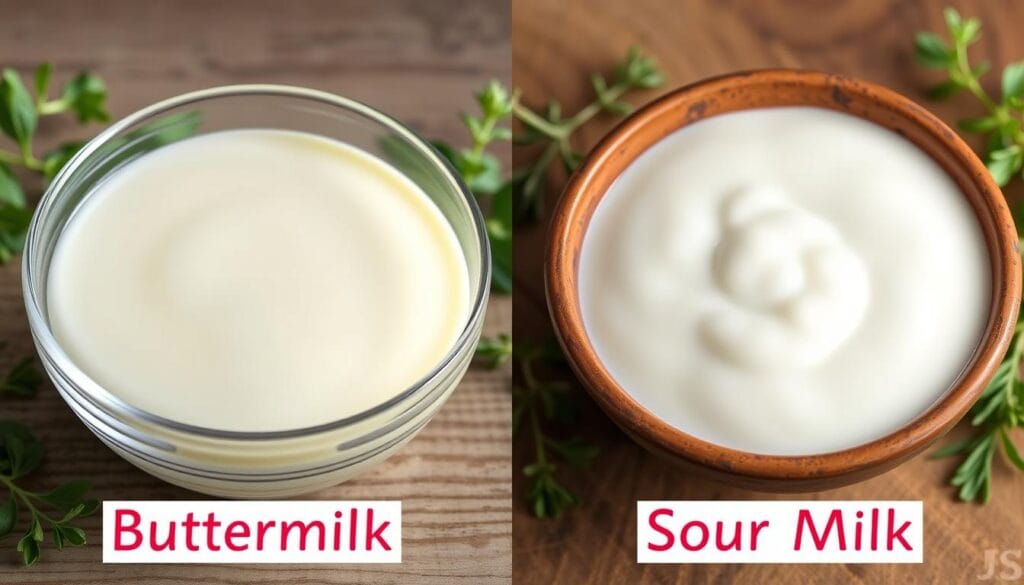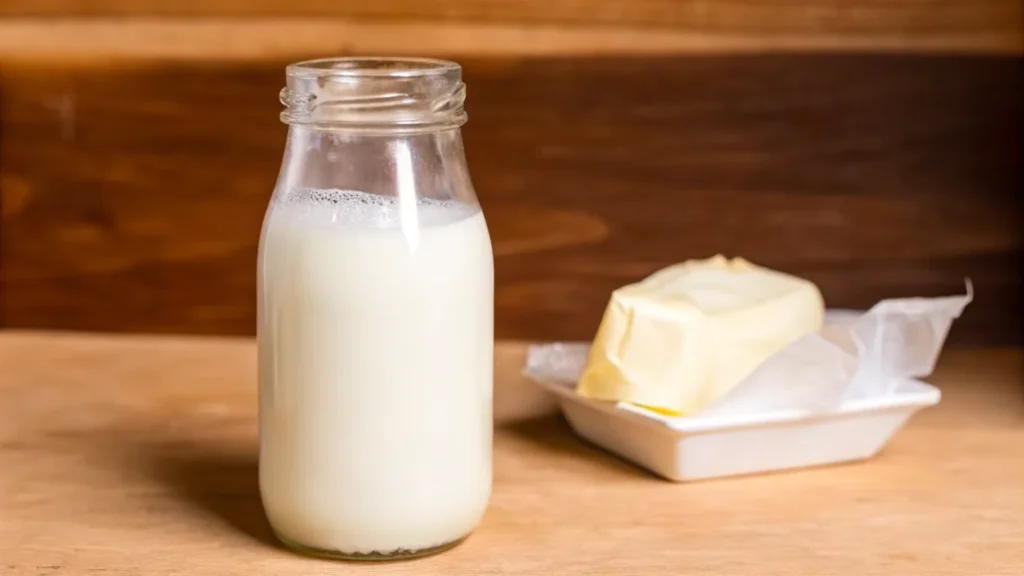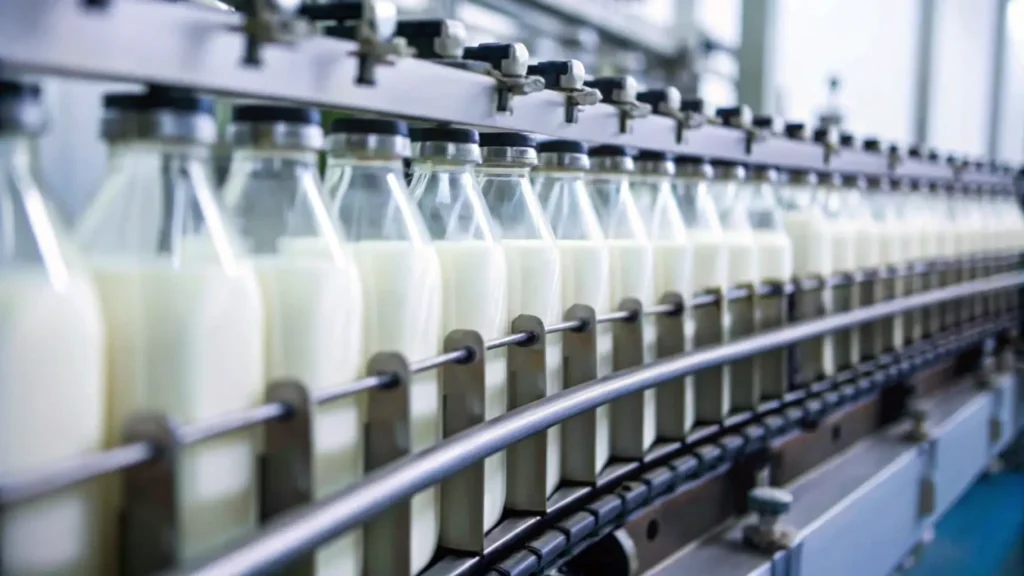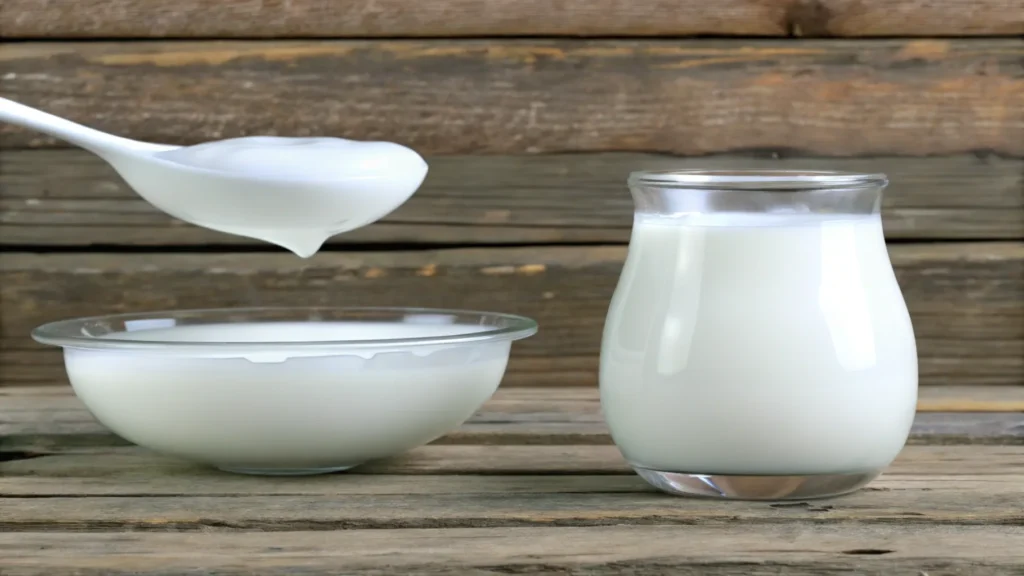
Ever stood in your kitchen, looking at a carton of milk and wondering about its tangy taste? The world of fermented milk is both interesting and tasty. Buttermilk and sour milk might seem the same, but they’re actually different. They can change how you cook and eat.
These dairy products have been around for a long time. They add special qualities to food and health. Buttermilk and sour milk look similar, but they’re not the same. Knowing the difference can make your cooking better and help you choose the right dairy products.
Buttermilk and sour milk have interesting stories behind them. They show how milk can change in different ways. They bring unique tastes, health benefits, and uses in cooking that can amaze anyone who cooks.
Table of contents
Understanding Traditional Buttermilk and Its Differences from Sour Milk
Traditional buttermilk has a deep history tied to farming. It comes from the old method of butter churning. This method shows how rural areas around the world used to make food.

Historical Origins of Buttermilk
In olden days, families in rural areas made buttermilk. They turned cream into butter through a slow process. Before fridges, they found that letting cream ferment made a useful product.
“Buttermilk was more than just a drink – it was a testament to agricultural ingenuity and resourcefulness.”
Traditional Production Methods
Butter churning had key steps to make traditional buttermilk:
- Collecting fresh cream from dairy animals
- Allowing natural bacterial fermentation
- Separating butterfat through mechanical churning
- Collecting the remaining liquid – true buttermilk
Cultural Significance Worldwide
Buttermilk is loved all over the world. Each place has its own way of making it. This shows how farming traditions vary globally.
| Region | Buttermilk Tradition | Cultural Use |
|---|---|---|
| India | Chaas (Spiced Buttermilk) | Cooling Summer Drink |
| Middle East | Fermented Dairy Beverages | Cooking & Preservation |
| European Countries | Traditional Butter Production | Culinary Ingredient |
Buttermilk’s rich history inspires today’s cooking. It connects past and present through its taste and health benefits.
Modern Commercial Buttermilk Production: How It Differs from Sour Milk
The way commercial dairy production makes cultured buttermilk has changed a lot. Today, modern makers use advanced methods to make a product that tastes great and is consistent. This meets what people want to buy.

- They pick the best raw milk.
- They pasteurize and homogenize it.
- They add special lactic acid bacteria cultures.
- They control how the bacteria work.
- They package it for stores to sell.
The secret to great cultured buttermilk is the right lactic acid bacteria. Strains like Lactococcus lactis and Lactobacillus bulgaricus turn milk into a tangy, thick drink.
“The science of buttermilk production is a delicate balance of microbiology and dairy engineering.” – Dairy Science Expert
Commercial buttermilk usually has about 1.5% butterfat. It might also have extra stuff to make it taste better and feel creamier. To make it healthier, they add vitamins A and D.
| Buttermilk Characteristic | Commercial Standard |
|---|---|
| Butterfat Content | 1.5% |
| Primary Bacteria Cultures | Lactococcus lactis, Lactobacillus bulgaricus |
| Typical Weight per Cup | 245 grams |
| Vitamin Fortification | Vitamins A and D |
The buttermilk market is growing worldwide. India is seeing a big increase, with a 22.4% growth rate from 2021 to 2026.
The Science Behind Sour Milk: A Key Difference to Buttermilk
Exploring milk spoilage takes us into the world of bacteria and chemical changes. From fresh to sour, milk undergoes complex processes. These changes affect both its safety and its use in cooking.

Chemical Process of Milk Souring
Lactic acid forms when certain bacteria break down milk’s sugars. This process alters milk’s nature through a detailed scientific process:
- Bacteria eat lactose
- Lactose turns into lactic acid
- Milk’s pH drops
- Protein structures start to change
Natural vs. Intentional Souring
Milk can sour in two ways: naturally or on purpose. Natural souring comes from unchecked bacteria growth. Intentional souring involves adding specific acids carefully.
| Souring Type | Process | Safety Level |
|---|---|---|
| Natural Souring | Random bacterial growth | Potentially Unsafe |
| Intentional Souring | Controlled acid addition | Safe for Consumption |
Safety Considerations
Food safety is key when dealing with milk and bacteria. Unchecked spoilage can lead to harmful microbes. Always check the smell, look, and expiration date before drinking.
“Not all soured milk is created equal – understanding the science protects your health.” – Food Safety Expert
Proper storage and handling lower the risks of milk spoilage. This way, you can enjoy dairy safely and with confidence.
What Is the Difference Between Buttermilk and Sour Milk?
Knowing the difference between buttermilk and sour milk can improve your cooking. These dairy products may seem alike, but they have unique qualities. This makes them different in the world of dairy.
The main differences between buttermilk and sour milk are in how they’re made and what they offer:
- Buttermilk is a cultured dairy product with consistent acidity and thickness
- Sour milk is simply milk that has naturally turned acidic
- Buttermilk offers more predictable probiotic benefits
Buttermilk is made through fermentation, which gives it a special taste and texture. On the other hand, sour milk happens when milk naturally goes bad or is aged on purpose.
| Characteristic | Buttermilk | Sour Milk |
|---|---|---|
| Production Method | Controlled fermentation | Natural souring |
| Consistency | Thick and uniform | Variable thickness |
| Flavor | Mild, tangy | Potentially stronger |
| Culinary Uses | Baking, marinades | Limited cooking applications |
“Not all sour dairy is created equal” – Culinary Expert
Buttermilk is often chosen for cooking because of its consistent quality and health benefits. Sour milk can be used as a substitute, but it might change your recipe’s texture and taste.
Culinary Applications of Buttermilk vs. Sour Milk
Buttermilk is a versatile ingredient that makes cooking and baking better. It’s great for making pancakes or tender marinades. This tangy dairy product opens up many culinary possibilities.
Baking Magic with Buttermilk
Baking with buttermilk makes treats light, fluffy, and delicious. Its acidity works with baking soda to make baked goods rise. Try it in Southern-style biscuits or decadent chocolate chip pancakes for added depth and tenderness.
- Homemade Confetti Cake
- Red Velvet Cheesecake
- Utah Buttermilk Scones
- Orange Buttermilk Cupcakes
Marinades that Tenderize
Buttermilk marinades are a chef’s secret for tender meats. The natural acids break down proteins, keeping fried chicken and chicken tenders juicy. Try coconut chicken tenders with Caribbean salsa for a taste of buttermilk’s marinating power.
Refreshing Buttermilk Drinks
Buttermilk is also great in drinks. It’s perfect for smoothies, traditional Indian lassi, and probiotic-rich drinks. With about 10 grams of protein per cup, it’s good for your digestive health and taste buds.
“Buttermilk transforms ordinary recipes into extraordinary culinary experiences.” – Culinary Expert
Cooking with Sour Milk: How It Differs from Buttermilk
Don’t throw away sour milk! Your kitchen can turn it into tasty dishes. Sour milk recipes help reduce waste and make food that’s delicious.
Baking with sour milk is a great way to use up old milk. Its acidity is perfect for many recipes, like:
- Pancakes
- Muffins
- Biscuits
- Cornbread
- Quick breads
When cooking with sour milk, safety is key. Make sure the milk has soured naturally and doesn’t have harmful bacteria. Whole milk gives the best results in recipes.
“Sour milk isn’t bad milk – it’s just milk waiting to become something delicious!” – Traditional Kitchen Wisdom
Here are some tips for using sour milk:
- Check milk for any unusual odors or mold before using
- Use within one week of refrigeration
- Freeze extra sour milk for future baking projects
Dairy-free cooks can try almond or coconut milk as substitutes. The trick is knowing how the acidity works with your recipe’s leavening agents.
Nutritional Comparison of Buttermilk and Sour Milk
Exploring buttermilk and sour milk shows they have special health benefits. Knowing their nutritional values helps you choose better foods.
Protein and Calcium Content
Buttermilk is a great source of important nutrients. A cup usually has:
- 8-10 grams of protein
- 285-300 milligrams of calcium
- Approximately 100-152 calories
Probiotic Dairy Benefits
Buttermilk is good for your digestion. The way it’s made adds good bacteria to your gut.
“Fermented dairy products can potentially improve digestive health and boost the immune system” – Nutrition Research
Caloric Values
Knowing how many calories are in low-fat dairy is key. Buttermilk has fewer calories than whole milk.
| Dairy Product | Calories per Cup | Fat Content |
|---|---|---|
| Whole Buttermilk | 152 | 8.1g |
| Low-Fat Buttermilk | 98 | 2.2g |
| Sour Milk | 103 | 2.5g |
Looking for probiotic benefits or watching calories? Buttermilk and sour milk are good choices.
Making Buttermilk Substitutes at Home vs. Repurposing Sour Milk
Making homemade buttermilk is simpler than you might think. With just a few ingredients, you can make buttermilk substitutes for your favorite recipes. The trick is to know how to acidify milk to get that tangy buttermilk taste.
Here are some easy ways to make acidified milk for buttermilk substitutes:
- Milk and Vinegar Method: Add 1 tablespoon of white vinegar to 1 cup of milk
- Lemon Juice Technique: Mix 1 tablespoon of lemon juice with 1 cup of milk
- Cream of Tartar Alternative: Combine 1¾ teaspoons cream of tartar with 1 cup of milk
“The secret to a great buttermilk substitute is creating the right acid-to-milk ratio”
Homemade buttermilk substitutes can meet different dietary needs. For those looking for lactose-free or vegan options, try:
- Unsweetened almond milk
- Soy milk
- Oat milk
- Coconut milk
Each milk type needs a bit of acid to turn into a buttermilk-like ingredient. It takes about 5-10 minutes for the milk to curdle and get that tangy taste.
| Milk Type | Acid | Ratio | Preparation Time |
|---|---|---|---|
| Whole Milk | White Vinegar | 1 cup : 1 tbsp | 5-10 minutes |
| Almond Milk | Lemon Juice | 1 cup : 1 tbsp | 5-10 minutes |
| Soy Milk | Apple Cider Vinegar | 1 cup : 1 tbsp | 5-10 minutes |
Pro tip: Keep your homemade buttermilk substitute in an airtight container in the fridge. It will last about a week, ready to use in your baking and cooking.
Storage and Shelf Life: Buttermilk vs. Sour Milk
Knowing how to store buttermilk and sour milk is key. Your fridge is essential for keeping these products fresh.
Cultured buttermilk can stay good in the fridge for three to four weeks after you open it. If it’s unopened, it can last up to two weeks past its expiration date.
“Proper storage is the secret to maximizing your buttermilk’s freshness and quality.” – Dairy Preservation Expert
Storage Guidelines
- Refrigerate buttermilk at 37°F (2.2°C)
- Keep container tightly sealed
- Store in the coldest part of the refrigerator
- Check for signs of spoilage before use
Freezing Options
Freezing is a great way to keep buttermilk fresh. You can freeze it for up to three months. Pro tip: Freeze in small portions for easier thawing and use.
| Storage Method | Refrigerated Shelf Life | Frozen Shelf Life |
|---|---|---|
| Cultured Buttermilk | 3-4 weeks | 3 months |
| Sour Milk | 3-5 days | Not recommended |
When thawing frozen buttermilk, use it within three to four days. Give it a good shake to restore its consistency. Freezing might change the texture a bit, but it’s great for baking and cooking.
Common Misconceptions About Buttermilk and Sour Milk
Buttermilk and sour milk often face many myths and misconceptions. Knowing the facts about dairy products helps you make better choices in cooking and nutrition.
Taste Differences Explained
Many think buttermilk and sour milk taste the same. But, they actually have different flavors. Buttermilk has a tangy, cultured taste that’s milder than sour milk. This comes from a special fermentation process.
Usage Myths Uncovered
Some believe you can use buttermilk and sour milk the same in all recipes. But, this isn’t always true because of their different properties:
- Buttermilk is a cultured product with specific leavening properties
- Sour milk might not provide the same chemical reactions in baking
- Professional bakers prefer cultured buttermilk for consistent results
Health Impact Beliefs
Buttermilk is actually a low-fat dairy product. Many think it’s high in calories, but it’s quite the opposite. It has beneficial probiotics and essential nutrients that support digestive health.
“Not all sour dairy products are created equal – understanding their unique characteristics is key to culinary success.” – Dairy Nutrition Expert
By clearing up these myths, you can make better choices about using buttermilk and sour milk in your diet and cooking.
FAQ:
1. Can sour milk be used in place of buttermilk?
Yes, sour milk can substitute buttermilk in baking, but the flavor and consistency may vary slightly.
2. What happens if I use sour cream instead of buttermilk?
Sour cream makes recipes thicker and creamier; thin it with milk for a closer match to buttermilk.
3. What does it mean when a recipe calls for sour milk?
It refers to milk soured with vinegar or lemon juice to create acidity for baking.
4. Can you drink sour milk?
Naturally soured milk is safe to drink, but spoiled milk (rancid smell or mold) is unsafe.
Conclusion
Exploring buttermilk vs sour milk shows they have special uses in cooking and baking. Buttermilk is great for making baked goods tender and fluffy. Its acidity is key.
Choosing the right dairy product can change how a recipe turns out. Buttermilk adds flavor and nutrients like calcium and vitamin B12. It’s more than just a milk substitute.
Knowing the difference between buttermilk and sour milk helps you cook better. Buttermilk is better for its cultured taste and health benefits. It’s perfect for both home cooks and chefs.
Learning about these dairy products lets you try new recipes with confidence. Whether baking, marinating, or making sauces, the right dairy makes a big difference. It’s all about creativity and choice.
